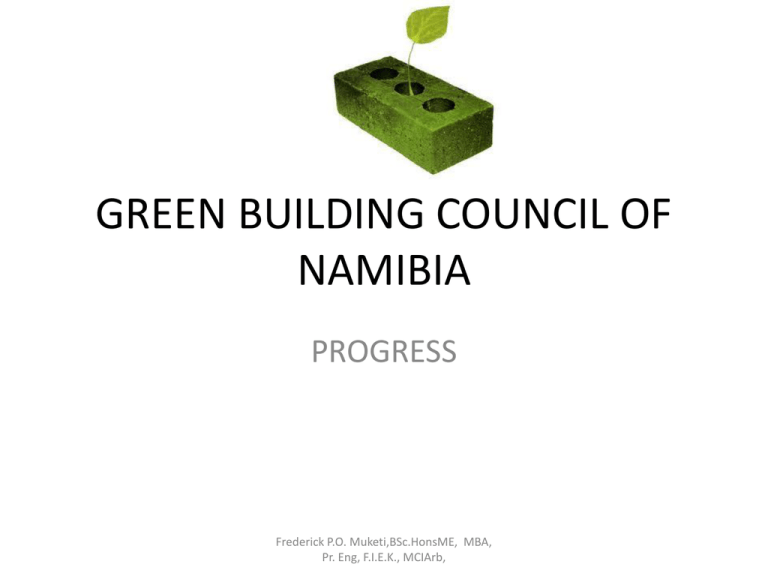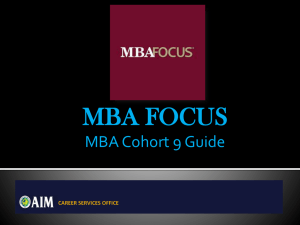Green Building Council Of Namibia Progress 2012-2014
advertisement

GREEN BUILDING COUNCIL OF NAMIBIA PROGRESS Frederick P.O. Muketi,BSc.HonsME, MBA, Pr. Eng, F.I.E.K., MCIArb, A Green Building Council definition • An official Green Building Council (GBC) is a national non-profit, non-government organization that is part of a global network recognized by the World Green Building Council . GBCs are "transparent, consensusbased, not-for-profit coalition-based organizations with no private ownership and diverse and integrated representation from all sectors of the property industry;" and their overarching goal is to promote a transformation of the built environment towards one that is sustainable (buildings and cities that are environmentally sensitive, economically viable, socially just and culturally significant). Frederick P.O. Muketi,BSc.HonsME, MBA, Pr. Eng, F.I.E.K., MCIArb, Logo of the World Green Building Council • WGBC acts as an umbrella organization for existing, emerging and developing GBCs around the world • As of October 2012, there were at least 19 nations with established GBCs, seven recognized as "emerging" members, and dozens more in the development process. As at now there are 26 established, 15 emerging, 33 prospective, and 28 Associated working groups, totaling 102. Frederick P.O. Muketi,BSc.HonsME, MBA, Pr. Eng, F.I.E.K., MCIArb, The 26 established councils are • • • • • • • • • • • Argentina GBC GBC of Australia GBC Brazil GBC of South Africa Canada GBC Chile GBC Colombia GBC Dutch GBC Emirates GBC France GBC German Sustainable Building Council • GBC of Espana • Hong Kong GBC • Indian GBC • Israel GBC • Japan Green Building Consortium • Jordan GBC • Peru GBC • Polish GBC • Singapore GBC • Sweden GBC • Turkish GBC • New Zealand GBC • Taiwan GBC • United Kingdom GBC • United States GBC Frederick P.O. Muketi,BSc.HonsME, MBA, Pr. Eng, F.I.E.K., MCIArb, Growth in numbers of Councils • As of July 2014 there were over 102 Green Building Councils at various stages of their development, an increase of about 30 in the last three years. • Many of these are growing rapidly and aspire to become full members. The successful model set by the Established Councils and overseen by the World Green Building Council (WGBC) supports and guides this growth – offering a powerful framework. • An example of this growth is the Green Building Council Russia, RuGBC, formed in 2009 and now already in Emerging Status, seeking established status. Frederick P.O. Muketi,BSc.HonsME, MBA, Pr. Eng, F.I.E.K., MCIArb, Councils use different rating tools: • Australia: Nabers / Green Star / BASIX (in NSW only) • Brazil: AQUA / LEED Brazil • Canada: LEED Canada / Green Globes / Built Green Canada • China: GBAS • Finland: PromisE • France: HQE • Germany: DGNB / CEPHEUS • Hong Kong: HKBEAM • India: Indian Green Building Council (IGBC)/ GBCIndia (Green Building Construction India)/ GRIHA • Indonesia: Green Building Council Indonesia (GBCI) / Greenship • Italy: Protocollo Itaca / Green Building Council Italia • Japan: CASBEE • Jordan: Jordan Green Building Council Frederick P.O. Muketi,BSc.HonsME, MBA, Pr. Eng, F.I.E.K., MCIArb, Councils use different rating tools: • Korea, Republic of: Green Building Certification Criteria / Korea Green Building Council • Malaysia: GBI Malaysia • Mexico: LEED Mexico • Netherlands: BREEAM Netherlands • New Zealand: Green Star NZ • Pakistan: Pakistan Green Building Council • Philippines: BERDE / Philippine Green Building Council • Portugal: Lider A / SBToolPT® • Qatar: • Republic of China (Taiwan): Green Building Label • Singapore: Green Mark • South Africa: Green Star SA • Spain: VERDE • Switzerland: Minergie Frederick P.O. Muketi,BSc.HonsME, MBA, Pr. Eng, F.I.E.K., MCIArb, Councils use different rating tools: • United States: LEED / Living Building Challenge / Green Globes / Build it Green / NAHB NGBS / International Green Construction Code (IGCC) / ENERGY STAR • United Kingdom: BREEAM • United Arab Emirates: Estidama • Turkey : [www.cedbik.org/ CEDBİK] • Thailand : TREES • Vietnam: LOTUS Rating Tools • Czech Republic: SBToolCZ Frederick P.O. Muketi,BSc.HonsME, MBA, Pr. Eng, F.I.E.K., MCIArb, GBCNA EVOLUTION • The Associated Working Group was formed in February 2012 to, amongst others, develop a business plan, secure funding, identify and invite members and register the GCBNA with the Namibian authorities and the World Green Building Council. • Relationship with Pricewaterhouse Coopers (PwC) grew into professional legal and financial accounting support • 10 August 2012: A 21-page trust deed was completed with the support of PwC to apply for registration with the Master of the High Court • The registration with the WGBC was achieved in September 2012 in Prospective Status • 23-25 October 2012: 3 representatives were sponsored by UNDP to attend the GBCSA 5th Convention and Exhibition in Cape Town Frederick P.O. Muketi,BSc.HonsME, MBA, Pr. Eng, F.I.E.K., MCIArb, GBCNA EVOLUTION • A database of stakeholders continued to take shape coming from industry, government, business and professional circles • Collaboration with GBCSA strengthened from October 2012 GBCSA 5th Convention • January 2013: FNB seeks association with GBCNA through WSP/GBCSA, prior to construction of their next Green Building up market • 04 March 2013 : A board of trustees is registered by the Master of High Court • 11 March 2013: WSP Engineering Group and GBCSA make a presentation on Green Star rating tool to GBCNA Associated Working Group in Windhoek at the Ministry of Works and Transport • 15 March 2013: The first Mini Convention of GBCNA is held at Habitat Research Development Centre Frederick P.O. Muketi,BSc.HonsME, MBA, Pr. Eng, F.I.E.K., MCIArb, GBCNA’s Immediate Future • GBCNA is established under a CEO functioning with employees, not by volunteers alone • A membership drive and database are in place • A Customer Relation Management system is in place • A marketing strategy is place • Corporate Governance strategy is in place • Register Corporate members in Platinum, Gold, Silver and Bronze Categories, and individuals. • A green building rating tool is recommended and adopted • A training and education programme is in place for trainers • A Financial Management system is in place • An HR strategy and system is adopted. • Attend the WGBC Convention in Cape Town in October 2013 in “Emerging Status” • Sponsorship deals are signed • A GBCNA website is fully functional Frederick P.O. Muketi,BSc.HonsME, MBA, Pr. Eng, F.I.E.K., MCIArb, 19 AFRICAN COUNTRIES’ STATUSES • Established - SOUTH AFRICA • Prospective Group – GHANA, KENYA, MAURITIUS, MOROCCO, NAMIBIA, NIGERIA • Associated Group – BENIN, BOTSWANA, EGYPT, MAURITANIA, TANZANIA, ZIMBABWE • Initiated Interest CAMEROON, GABON, IVORY COAST, RWANDA, SUDAN, ZAMBIA Frederick P.O. Muketi,BSc.HonsME, MBA, Pr. Eng, F.I.E.K., MCIArb, Why Green Star Rating Tool • Green Star is a voluntary environmental rating system for buildings in Australia. It was launched in 2003 by the Green Building Council of Australia. • The system considers a broad range of practices for reducing the environmental impact of buildings and to showcase innovation in sustainable building practices, while also considering occupant health and productivity and cost savings. The resulting score is translated into "Green Stars" as follows: • Score 45-59: 4 Star Green Star, signifies 'Best Practice' in environmentally sustainable design and/or construction • Score 60-74: 5 Star Green Star, signifies 'Australian Excellence’ • Score 75-100: 6 Star Green Star, signifies 'World Leadership' Frederick P.O. Muketi,BSc.HonsME, MBA, Pr. Eng, F.I.E.K., MCIArb, Why Green Star rating tool? Wholistic Nine categories assessed with the Green Star Rating tools: 1. Management, 2. Indoor Environment Quality, 3. Energy, 4. Transport, 5. Water, 6. Materials, 7. Land use & ecology, 8. Emissions, 9. Innovation. Frederick P.O. Muketi,BSc.HonsME, MBA, Pr. Eng, F.I.E.K., MCIArb, Why Green Star Rating Tool • “We believe these highways are contributing to the development of African infrastructures. Namibia recently designated the Ministry of Works and Transport as Namibia’s Champion for Infrastructure Projects and communicated this information to the NEPAD Agency, “ Pohamba said (Jan 2012) • The New Partnership for Africa's Development (NEPAD) is a programme of the African Union created by Africans, for Africans and implemented by Africans. Frederick P.O. Muketi,BSc.HonsME, MBA, Pr. Eng, F.I.E.K., MCIArb, Why Green Star Rating Tool • GBCSA has taken a leading role to get many African countries supported. Namibia is closest in links with SA Building codes and standards. • LEED is taken by USA, Canada, Mexico, Brazil, for obvious regional connectivity and intertrade historical ties • GBCSA sees GBCNA excitedly as a kid-brother and are willing to train. • GBCSA has seen the support by GBA as a lesson to pass on their experiences to others. • WGBC recognizes GBCSA as the one with capacity to support the African continent • Present WGBC Chair is Bruce Kerswill of SA Frederick P.O. Muketi,BSc.HonsME, MBA, Pr. Eng, F.I.E.K., MCIArb, Case of GBCSA • After just seven years the Green Building Council South Africa has certified its 59th building. The GBCSA has single handedly activated and supported the commercial property sector towards a greener future, making way for green buildings. • The Council developed a series of Green Star SA rating tools based on the internationally-respected Australian rating system, customized for the South African context. This set the standards for green building providing clear guidelines on what constitutes a ‘green building’. • • It is a voluntary rating system designed to allow the commercial property sector to independently rate and certify buildings and developments via a common green building ‘language’. The tool for new buildings encourages the built environment stakeholders and professionals to minimize the environmental impacts of their developments. Amongst other things it rewards projects for initiatives that see a reduction in waste sent to landfill and the creation of more resource efficient designs. Frederick P.O. Muketi,BSc.HonsME, MBA, Pr. Eng, F.I.E.K., MCIArb, Green Star SA Certification • The overall result is a building with reduced energy and water • • • • consumption and lower operating costs. The Green Star SA tools allow for certification of buildings based on the following levels of achievement: 4 Star Green Star SA Certification – ‘Best Practice’ 5 Star Green Star SA Certification – ‘South African Excellence’ 6 Star Green Star SA Certification – ‘World Leadership’ • • “The GBCSA could not have achieved the success it has to date without the support of some very big players in the sector that have pioneered the way to a better place for people and the planet. The support has been widespread but of most significance is the take up of Green Star SA by Government bodies and big businesses such as banks and property developers,” says Brian Wilkinson, CEO of the Green Building Council South Africa. [13 April 2014] Frederick P.O. Muketi, BSc.HonsME, MBA, Pr. Eng, F.I.E.K., MCIArb, Green Star SA Rating • “Globally, the built environment is responsible for one third of all carbon emissions and with global warming a very real concern that affects us all, a shift in focus to green building is something that should be foremost in everyone’s minds – from government, to developers, to the average man in the street.” • “It’s encouraging to see the country’s leadership take up international best practice when it comes to green buildings and we are delighted that there are nine government buildings certified to date. One of the only three 6-star buildings to be certified so far in South Africa is also in this category,” says Wilkinson Frederick P.O. Muketi,BSc.HonsME, MBA, Pr. Eng, F.I.E.K., MCIArb, THANK YOU Frederick P.O. Muketi,BSc.HonsME, MBA, Pr. Eng, F.I.E.K., MCIArb,







